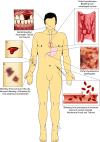Treatment of bleeding in patients with liver disease
- PMID: 33974330
- PMCID: PMC8362012
- DOI: 10.1111/jth.15364
Treatment of bleeding in patients with liver disease
Abstract
Patients with cirrhosis frequently have complex alterations in their hemostatic system. Although routine diagnostic tests of hemostasis in cirrhosis (platelet count, prothrombin time, fibrinogen level) are suggestive of a bleeding tendency, it is now widely accepted that these tests do not reflect hemostatic competence in this population. Rather, patients with cirrhosis appear to have a rebalanced hemostatic system with hypercoagulable elements. Therefore, routine correction of hemostasis laboratory values, for example by fresh frozen plasma or platelet concentrates, with the aim to avoid spontaneous or procedure-related bleeding is not indicated as is outlined in recent clinical guidance documents. However, little guidance on how to manage patients with cirrhosis that are actively bleeding is available. Here we present three common bleeding scenarios, variceal bleeding, post-procedural bleeding and bleeding in a critically ill cirrhosis patient, with specific management suggestions. As patients with cirrhosis generally have adequate hemostatic competence and as bleeding complications may be unrelated to hemostatic failure, prohemostatic therapy is not the first line of management in bleeding patients with cirrhosis, even in the presence of markedly abnormal platelet counts and/or prothrombin times. We provide a rationale for the restrictive approach to prohemostatic therapy in bleeding patients with cirrhosis.
Keywords: antifibrinolytic agents; blood transfusion; platelet transfusion; portal hypertension; prothrombin time.
© 2021 The Authors. Journal of Thrombosis and Haemostasis published by Wiley Periodicals LLC on behalf of International Society on Thrombosis and Haemostasis.
Conflict of interest statement
The authors have no financial conflict of interests with the material covered in this manuscript.
Figures


Similar articles
-
Haemostatic alterations and management of haemostasis in patients with cirrhosis.J Hepatol. 2022 Jun;76(6):1291-1305. doi: 10.1016/j.jhep.2021.11.004. J Hepatol. 2022. PMID: 35589251 Review.
-
AGA Clinical Practice Update: Coagulation in Cirrhosis.Gastroenterology. 2019 Jul;157(1):34-43.e1. doi: 10.1053/j.gastro.2019.03.070. Epub 2019 Apr 12. Gastroenterology. 2019. PMID: 30986390 Review.
-
[Liver cirrhosis--procoagulant stasis].Rev Med Chir Soc Med Nat Iasi. 2011 Jul-Sep;115(3):678-85. Rev Med Chir Soc Med Nat Iasi. 2011. PMID: 22046771 Romanian.
-
Novel insights into the assessment of risk of upper gastrointestinal bleeding in decompensated cirrhotic children.Pediatr Transplant. 2019 Jun;23(4):e13390. doi: 10.1111/petr.13390. Epub 2019 Mar 19. Pediatr Transplant. 2019. PMID: 30888111
-
Management of Thrombocytopenia and Coagulopathy in Patients with Chronic Liver Disease Undergoing Therapeutic Endoscopic Interventions.Clin Liver Dis. 2022 Feb;26(1):1-12. doi: 10.1016/j.cld.2021.08.002. Epub 2021 Sep 17. Clin Liver Dis. 2022. PMID: 34802655 Review.
Cited by
-
Acute Necrotizing Pancreatitis Leading to Hemosuccus Pancreaticus and Hemorrhagic Shock in the Setting of Decompensated Cirrhosis.Cureus. 2024 Dec 4;16(12):e75111. doi: 10.7759/cureus.75111. eCollection 2024 Dec. Cureus. 2024. PMID: 39759699 Free PMC article.
-
Blood products and liver transplantation: A strategy to balance optimal preparation with effective blood stewardship.Transfusion. 2022 Oct;62(10):2057-2067. doi: 10.1111/trf.17074. Epub 2022 Aug 20. Transfusion. 2022. PMID: 35986654 Free PMC article.
-
Novel horizons in anticoagulation: the emerging role of factor XI inhibitors across different settings.Haematologica. 2024 Oct 1;109(10):3110-3124. doi: 10.3324/haematol.2023.283682. Haematologica. 2024. PMID: 38779744 Free PMC article. Review.
-
Bleeding and Thrombosis in Patients With Cirrhosis: What's New?Hemasphere. 2023 May 23;7(6):e886. doi: 10.1097/HS9.0000000000000886. eCollection 2023 Jun. Hemasphere. 2023. PMID: 37234821 Free PMC article. No abstract available.
-
Bleeding recurrence risk among hospitalized patients undergoing therapeutic plasma exchange: a multi-center study.Blood Transfus. 2024 Sep;22(5):420-428. doi: 10.2450/BloodTransfus.722. Epub 2024 Jul 19. Blood Transfus. 2024. PMID: 39133623 Free PMC article.
References
-
- Spyropoulos AC, Brohi K, Caprini J, et al. Scientific and Standardization Committee Communication: Guidance document on the periprocedural management of patients on chronic oral anticoagulant therapy: Recommendations for standardized reporting of procedural/surgical bleed risk and patient‐specific thromboembolic risk. J Thromb Haemost. 2019;17:1966‐1972. 10.1111/jth.14598 - DOI - PubMed
-
- Shakur H, Roberts I, Fawole B, et al. Effect of early tranexamic acid administration on mortality, hysterectomy, and other morbidities in women with post‐partum haemorrhage (WOMAN): an international, randomised, double‐blind, placebo‐controlled trial. Lancet. 2017;389:2105‐2116. 10.1016/S0140-6736(17)30638-4 - DOI - PMC - PubMed
MeSH terms
LinkOut - more resources
Full Text Sources
Other Literature Sources
Medical
Research Materials

